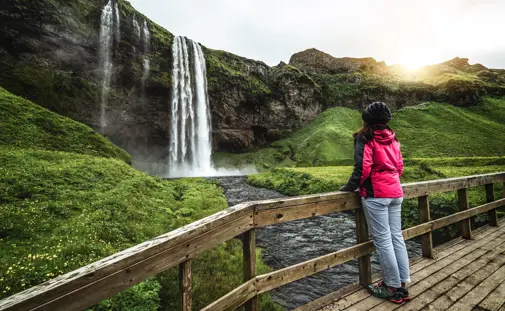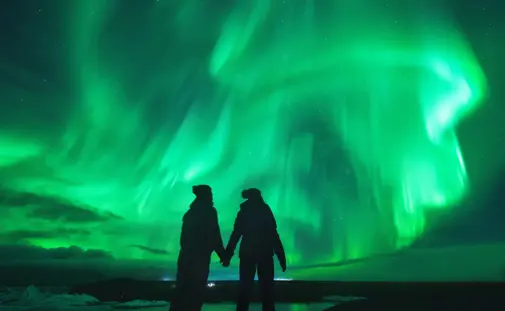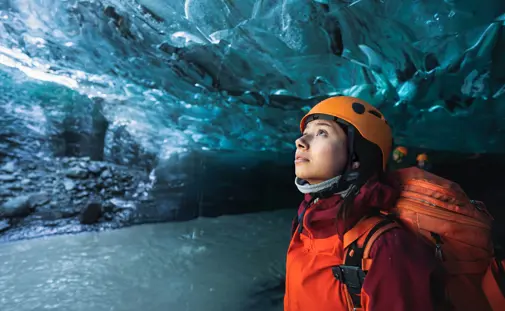Eyjafjallajökull is one of Iceland’s most famous and active volcanoes, located in the southern part of the country beneath a glacier of the same name. The volcano gained worldwide attention in 2010 when it erupted, sending a massive plume of ash high into the atmosphere. This eruption disrupted air travel across Europe for several weeks, highlighting the powerful impact of Iceland’s volcanic activity on the global stage.
The glacier that covers the volcano, also named Eyjafjallajökull, spans about 100 square kilometers (39 square miles) and adds a stunning layer of ice to the already dramatic landscape. The area around Eyjafjallajökull is a popular destination for tourists, offering breathtaking views of the glacier, lush green valleys, and nearby waterfalls like Seljalandsfoss and Skógafoss.
Eyjafjallajökull Facts
Eyjafjallajökull is a stratovolcano located in the southern part of Iceland, under the Eyjafjallajökull glacier. Here are some key facts about the volcano and glacier:
-
Type of volcano: Stratovolcano
-
Type of glacier: Ice cap
-
Height: 1,651 meters (5,417 feet)
-
Glacier area: 100 km²
-
Last eruption: April 2010
-
First recorded eruption: 1821-1823
-
Eruptions: At least four documented eruptions
-
Age: Approximately 780,000 years old
History of Eyjafjallajökull
The history of Eyjafjallajökull represents a fascinating relationship between volcanic and glacial forces. Formed around 780,000 years ago, the stratovolcano became part of a volcanic ridge that bisects southern Iceland. On its summit, the glacier has covered this volcano for several thousand years. However, the great eruptions of Eyjafjallajökull have taken place over the last few centuries, though it became famous during its eruption in 2010.
The glacier itself is an important part of the ecosystem, feeding rivers that are related to human life and all other wildlife. Historically, the area surrounding Eyjafjallajökull has been inhabited by farming communities, who have lived in harmony with the volcanic landscape.
Eruptions
Eyjafjallajökull has had four recorded eruptions:
-
920 AD – The first known eruption.
-
1612 – This event caused significant ashfall, affecting nearby settlements.
-
1821-1823 – The longest-known eruption, causing ash clouds and glacial flooding.
-
2010 – The famous eruption that halted air traffic across Europe due to the ash plume.
Geology and Surroundings
Eyjafjallajökull is on the Eastern Volcanic Zone of Iceland, at the marking between the North American and Eurasian tectonic plates. It forms part of an extremely extensive system that includes many of the other nearby volcanoes, one of which is Katla, which lies under the Mýrdalsjökull glacier. The caldera of Eyjafjallajökull is about 4 km in diameter and has a glacier; hence, which significantly impacts the volcano’s eruptions by generating meltwater and causing flooding during volcanic activity.
Surrounding the volcano are many natural attractions such as:
Seljalandsfoss Waterfall: Located just west of Eyjafjallajökull, Seljalandsfoss offers visitors a stunning view and a unique experience of walking behind the waterfall.
Skógafoss Waterfall: Further south, Skógafoss is one of Iceland’s largest waterfalls, with a 60-meter drop.
Þórsmörk Valley: Located in the shadow of the volcano, Þórsmörk is a lush green valley is a popular hiking destination and showcases Iceland's diverse landscapes.
Eyjafjallajökull Today
The Volcano
It is still considered an active stratovolcano, despite its current dormant state. The 2010 eruption created ash plumes up to 30,000 feet and left its mark on the surrounding landscape and heavily impacted air travel across the globe, grounding flights across Europe for nearly a week. In fact, ash from the eruption blanketed nearby farms, reshaping the immediate terrain and affecting agricultural productivity in the area.
With time, the volcano has returned to a relative state of calm; it’s closely monitored by geologists who track seismic activity, gas emissions, and temperature changes within the region. Iceland's Meteorological Office continues to monitor this and other active volcanoes through an extensive network of seismographs and GPS placed to measure any shifts beneath Eyjafjallajökull's surface. Future eruptions, while unpredictable, remain possible given the volcano’s geological activity and placement on the North Atlantic Rift.
Considering Eyjafjallajökull's history of eruption, going as far back as the 9th century, it can be noted that this particular volcano usually has a tendency to erupt every few hundred years; thus, it may be dormant today but has the capability to erupt again in the near future.
The Glacier
While Eyjafjallajökull's glacier still crowns the volcano, it has retreated a long way in recent decades because of climate change. Like many of Iceland's glaciers, it’s shrinking as temperatures rise, reducing the size of the ice cap and revealing an increasingly large area of the volcano's rugged, rocky terrain.
Glaciologists have noticed that the glacier has been losing mass at an increasing rate, and if these warming trends continue, projections calculate that it could shrink dramatically, or even disappear within the next hundred years. Eventually, this affects not only the landscape but also the hydrology of the region. Glacier rivers and streams feed many rivers and streams across Iceland, and a lesser glacier volume on Eyjafjallajökull might eventually affect water supplies for the surrounding region.
The present retreat of the glacier offers a rare opportunity to understand how newly exposed volcanic landscapes evolved. The most dramatic view of ice set against dark volcanic rocks forms a striking landscape, which has piqued the interest of scientists and visitors.
In the meantime, Eyjafjallajökull continues to attract visitors intrigued by the interaction of ice and fire, a defining feature of Iceland's dynamic natural environment.
Exploring Eyjafjallajökull
Exploring Eyjafjallajökull offers an exciting array of experiences, whether you’re a seasoned hiker or a visitor wanting to take in the sights. Begin your journey at the Eyjafjallajökull Info Point at the old Eyjafjallajökull Erupts Visitor Center, which has been permanently closed, but the informative signs outside are present. Here, you’ll gain a fantastic view of the volcano and can immerse yourself in the story of its 2010 eruption. Close by, the Skógar Museum provides even deeper insight into the area’s volcanic history, allowing you to discover how eruptions have shaped the region over time.
More physically adventurous, the hike to Eyjafjallajökull's glacier presents a thrilling way to experience the landscape. From its starting point at Fimmvörðuháls, visitors find the popular 14 kilometer (8.7 miles) trail leading directly to the site of the 2010 eruption. This challenging route, taking roughly 10 to 12 hours, promises incredible views and a powerful sense of the volcano's presence. Suitable preparation and equipment are necessary due to the sometimes rugged terrain and unpredictable conditions.
If you are anxious to get near the glacier's ice surface, it is safest to take a guided tour in this landscape full of crevasses. Skilled guides will ensure a secure and memorable experience, navigating the shifting ice formations and sharing insights on Eyjafjallajökull’s unique natural features.
Where is Eyjafjallajökull?
Eyjafjallajökull is located in southern Iceland, approximately 125 kilometers (78 miles) from Reykjavík. Located at the foot of the volcano are the famous Skógarfoss and Seljalandsfoss.
-
The GPS coordinates are 63.6314° N, 19.6136° W.
How to Get to Eyjafjallajökull Glacier?
-
From Reykjavík: Drive along Route 1 (Ring Road) towards the south coast. The journey takes about 2 hours by car.
-
From Vík: Drive west along Route 1 for about 40 minutes.
-
From Höfn: It’s a longer drive, taking approximately 4 hours along Route 1.
You can view the glacier from the Eyjafjallajökull Info Point located along Route 1, close to Seljalandsfoss. Another great viewing point is from the visitor center at Skógar Museum, which also provides historical information about the 2010 eruption.




